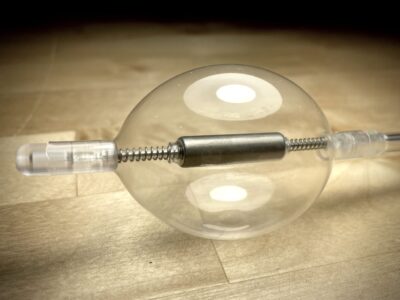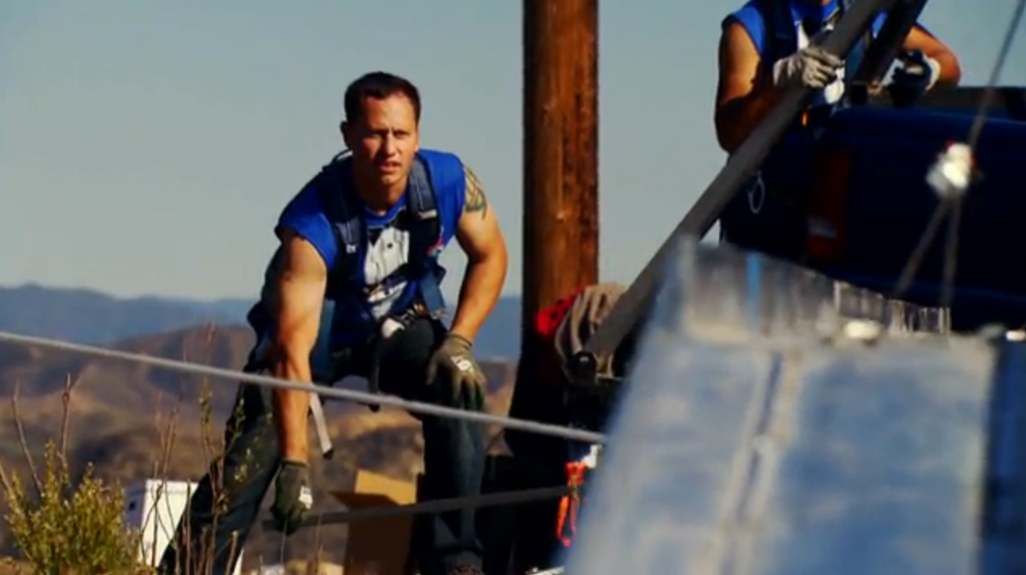With $50,000 on the line, all mechanical engineer and UMBC grad Corey Fleischer had to do was build a collapsible bridge that could be carried in the bed of a pickup truck, span a 30-plus-foot chasm when deployed and carry the weight — 3,400 pounds — of the same truck that transported the unassembled bridge.
Over five days last December, the now 32 year-old Fleischer led a team of four fellow engineers as they built a bridge that successfully allowed their pickup truck to cross the chasm. As a result, not only did he win a $50,000 grand prize, but he also won a one-year contract with the design and engineering firm WET.

Fleischer and the Blue Team look on as the pickup travels across their bridge.
The bridge build was the eighth and final challenge of “The Big Brain Theory: Pure Genius,” the new Discovery Channel show that recruited 10 engineers from across the U.S., relocated them to southern California for almost two months, and had them compete in engineering-focused challenges each week.
- The 10 contestants from different engineering fields were divided into two teams each week.
- Each team had a fixed budget of $10,000 or less and several days to create different mechanical systems: robots that could toss javelins, elevators that ran on water power, car-catchers that would automatically stop rogue vehicles at security checkpoints, and more.
Two contestants were from Maryland: Fleischer, a single father of two who lives in Harford County and works at Lockheed Martin in Baltimore, and Andrew Stroup, an engineer and civil servant for the Department of Defense who lives in Canton.
Read Stroup’s recaps of episodes from the first season of “The Big Brain Theory.”
Fleischer, who along with Stroup is a cofounder of the new Baltimore Foundery downtown makerspace, spoke with Technically Baltimore about his “Big Brain” win.
TB: Buzz Aldrin was a guest judge for the final challenge. How did it feel to shake his hand?
CF: It was ridiculous. That guy’s been on the moon, and I shook his hand. It was unreal to meet him. That was amazing.
TB: What are you going to do with your $50,000 grand prize?
CF: I really don’t have anything to put it toward right now. Really, maybe if something comes along — I would love to put the money toward developing some sort of product.
TB: What about the one-year contract with WET? Would you have to relocate to California if you took the contract?
CF: Right now I haven’t decided whether I’m going to take the contract. I don’t have to take the contract. And I’m not going to be able to relocate.
TB: The show finished shooting in late 2012, and you were in California the whole time. Was it hard on your children?
CF: It was definitely so hard on them. They mainly just wanted me to come home. The show wrapped up in mid-December. We were out there for seven-and-a-half weeks. I got to talk to my kids. Twice a week, we got 15 minutes of phone time, but I couldn’t say anything about the show. So it was really weird. So they had no idea, as they’re talking to me, that I kept winning these challenges.
TB: The bridge you and your team put together seemed fairly simple. Was that deliberate?
CF: I made the decision to go with what we knew would work. As an engineer, if a customer came to me and said, ‘I need you to build a bridge that performs this,’ I wouldn’t do something more expensive and elaborate for the sake of doing it.

The bridge the Blue Team designed. In the background is “Big Brain” host, Kal Penn, and the judges, including guest judge Buzz Aldrin on the far right.
TB: But wasn’t the point of the show to come up with innovative designs to classic engineering problems?
CF: Tom [another contestant] said at one point, ‘Being innovative for the sake of being innovative is ridiculous.’ And I agree with that. When you build something that’s never been developed before, you’re going to run into problems that have never been solved before. On the show, you’re not going to come up with innovative solutions to these problems. You’re going to do it the way it’s always been done.
TB: Discovery sort of billed this show as a way to highlight engineering, and demonstrate that the U.S. still turns out people who are skilled in math and science. Do you think the show accomplished that?
CF: They had the material there to really show off engineering and what engineering can do. And they do, they show what our builds were able to pull off in the short time frame. But they edited out all the math, all the calculations. They didn’t even show the video shots of our mechanisms working. But they did the best they did to get as many people to watch the show as possible, which is still a huge win for engineering.
Join the conversation!
Find news, events, jobs and people who share your interests on Technical.ly's open community Slack

Baltimore daily roundup: Medtech made in Baltimore; Sen. Sanders visits Morgan State; Humane Ai review debate

Baltimore daily roundup: An HBCU innovation champion's journey; Sen. Sanders visits Morgan State; Humane Ai review debate

Baltimore daily roundup: The city's new esports lab; a conference in Wilmington; GBC reports $4B of economic activity


